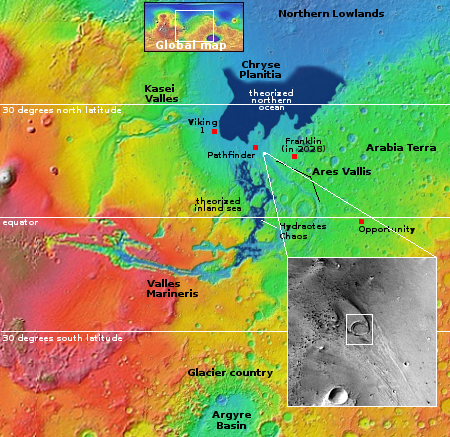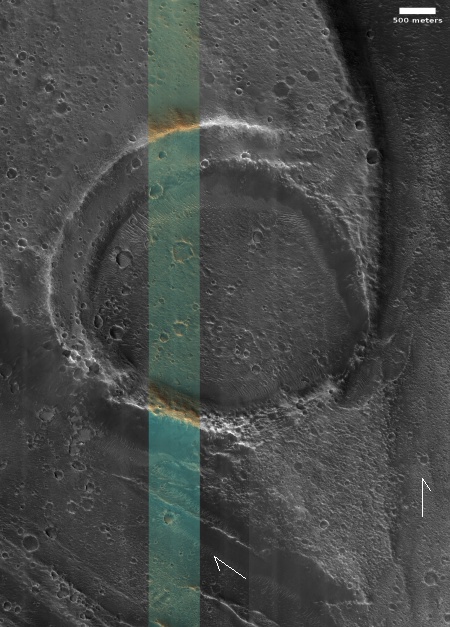The obvious visual evidence for assuming Mars once had catastrophic floods
Since the first comprehensive orbital data of Mars was sent back in the early 1970s by Mariner 9, scientists have generally concluded that many of the features seen at the eastern end of the giant Valles Marineris canyon were caused by one or several catastrophic floods.
The picture to the right, rotated, cropped, and reduced to post here and taken on July 26, 2024 by the high resolution camera on Mars Reconnaissance Orbiter (MRO), provides a good example of why the scientists have come to that conclusion. It shows what the camera team labels a “streamline feature surrounding crater.” I have added the arrows to indicate the presumed direction of flow. The flow went around this 2.5-mile-wide unnamed crater because the impact had compacted it, making it resistent to erosion. The flow however was strong and large enough to wash away the plateau on which the crater sits, as well as cutting into the crater’s southwest rim. In addition, the rim on the southeast was also cut through at some point, this time from what might have been flow eddies as the flood pushed past.
Hence, the theory of catastrophic floods.

The white dot on the overview map to the right marks the location, about 60 miles southeast of where Mars Pathfinder and its Sojourner rover landed in 1997. The inset gives a wider view, which shows more clearly the entire streamlined geology around this crater. In this case, the flood that washed around this crater came out of the long Ares Vallis channel, whose source is not Valles Marineris but the cratered highlands to its east.
As must be stated every time this hypothesis of Martian catastrophic floods comes up, the theory has problems. Though all the features both in close-up and in all the surrounding terrain looks like a sudden flash flood of gigantic proportions had come through — including data that suggests the past existence of intermittent oceans and seas following those floods — the fundamental problem is that planetary scientists have yet to come up with an acceptable model what would make liquid water possible on the surface of Mars, now or anytime in the past. The visual and orbital evidence insists on giant flash floods, but the long term geological and atmospheric evidence says no. The planet was always to cold with too thin an atmosphere. There are models that posit the atmosphere was once thicker and warmer, but no one is convinced by any of them.
Nonetheless, this picture illustrates why catastrophic floods are believed to occur on Mars. It will likely take scientists on the surface, with rock hammer in hand, to solve this mystery.
On Christmas Eve 1968 three Americans became the first humans to visit another world. What they did to celebrate was unexpected and profound, and will be remembered throughout all human history. Genesis: the Story of Apollo 8, Robert Zimmerman's classic history of humanity's first journey to another world, tells that story, and it is now available as both an ebook and an audiobook, both with a foreword by Valerie Anders and a new introduction by Robert Zimmerman.
The print edition can be purchased at Amazon or from any other book seller. If you want an autographed copy the price is $60 for the hardback and $45 for the paperback, plus $8 shipping for each. Go here for purchasing details. The ebook is available everywhere for $5.99 (before discount) at amazon, or direct from my ebook publisher, ebookit. If you buy it from ebookit you don't support the big tech companies and the author gets a bigger cut much sooner.
The audiobook is also available at all these vendors, and is also free with a 30-day trial membership to Audible.
"Not simply about one mission, [Genesis] is also the history of America's quest for the moon... Zimmerman has done a masterful job of tying disparate events together into a solid account of one of America's greatest human triumphs."--San Antonio Express-News
Since the first comprehensive orbital data of Mars was sent back in the early 1970s by Mariner 9, scientists have generally concluded that many of the features seen at the eastern end of the giant Valles Marineris canyon were caused by one or several catastrophic floods.
The picture to the right, rotated, cropped, and reduced to post here and taken on July 26, 2024 by the high resolution camera on Mars Reconnaissance Orbiter (MRO), provides a good example of why the scientists have come to that conclusion. It shows what the camera team labels a “streamline feature surrounding crater.” I have added the arrows to indicate the presumed direction of flow. The flow went around this 2.5-mile-wide unnamed crater because the impact had compacted it, making it resistent to erosion. The flow however was strong and large enough to wash away the plateau on which the crater sits, as well as cutting into the crater’s southwest rim. In addition, the rim on the southeast was also cut through at some point, this time from what might have been flow eddies as the flood pushed past.
Hence, the theory of catastrophic floods.

The white dot on the overview map to the right marks the location, about 60 miles southeast of where Mars Pathfinder and its Sojourner rover landed in 1997. The inset gives a wider view, which shows more clearly the entire streamlined geology around this crater. In this case, the flood that washed around this crater came out of the long Ares Vallis channel, whose source is not Valles Marineris but the cratered highlands to its east.
As must be stated every time this hypothesis of Martian catastrophic floods comes up, the theory has problems. Though all the features both in close-up and in all the surrounding terrain looks like a sudden flash flood of gigantic proportions had come through — including data that suggests the past existence of intermittent oceans and seas following those floods — the fundamental problem is that planetary scientists have yet to come up with an acceptable model what would make liquid water possible on the surface of Mars, now or anytime in the past. The visual and orbital evidence insists on giant flash floods, but the long term geological and atmospheric evidence says no. The planet was always to cold with too thin an atmosphere. There are models that posit the atmosphere was once thicker and warmer, but no one is convinced by any of them.
Nonetheless, this picture illustrates why catastrophic floods are believed to occur on Mars. It will likely take scientists on the surface, with rock hammer in hand, to solve this mystery.
On Christmas Eve 1968 three Americans became the first humans to visit another world. What they did to celebrate was unexpected and profound, and will be remembered throughout all human history. Genesis: the Story of Apollo 8, Robert Zimmerman's classic history of humanity's first journey to another world, tells that story, and it is now available as both an ebook and an audiobook, both with a foreword by Valerie Anders and a new introduction by Robert Zimmerman.
The print edition can be purchased at Amazon or from any other book seller. If you want an autographed copy the price is $60 for the hardback and $45 for the paperback, plus $8 shipping for each. Go here for purchasing details. The ebook is available everywhere for $5.99 (before discount) at amazon, or direct from my ebook publisher, ebookit. If you buy it from ebookit you don't support the big tech companies and the author gets a bigger cut much sooner.
The audiobook is also available at all these vendors, and is also free with a 30-day trial membership to Audible.
"Not simply about one mission, [Genesis] is also the history of America's quest for the moon... Zimmerman has done a masterful job of tying disparate events together into a solid account of one of America's greatest human triumphs."--San Antonio Express-News



Zimmerman wrote;
“the fundamental problem is that planetary scientists have yet to come up with an acceptable model what would make liquid water possible on the surface of Mars, now or anytime in the past. The visual and orbital evidence insists on giant flash floods, but the long term geological and atmospheric evidence says no. The planet was always to cold with too thin an atmosphere. There are models that posit the atmosphere was once thicker and warmer, but no one is convinced by any of them“
I also did not believe that Mars had any water for the same reasons, but the evidence, since the wonderful pictures in the last two decades have observed, appears to be otherwise almost everywhere we look.
There must be a compromise, an “outside the box” type of an event. something that will also explain the extra water that earth has, the extra atmosphere that Venus has, the ice covering Europa…
The best hypothesis that I can think of is a supernova remanent cloud rising up the local chimney passing through our solar system enveloping all the planets, and dimming the sun with a variety of gases. All of the planets would’ve been affected, Earth would experience it’s first Ice Age and a collapse of it’s atmosphere as the oxygen is reduced to water and the nitrogen levels become dominant, killing the dinosaurs…
Mars could’ve looked like Europa before the cloud eventually passed. (this would explain the cliff wall around Mount Olympus?) The air pressure would be high enough for a liquid water to exist for a short time, creating the evidence that we see before mars resumed it’s frozen state for the next Epoch of time. The most relevant evidence besides the flood planes is this still existing north and south pole ice caps… A remanent of the once covered planet.
I truly hope Elon musk succeeds and putting a man on Mars soon, one with “hammer in hand” to reveal the mystery in our lifetime.